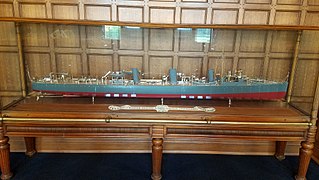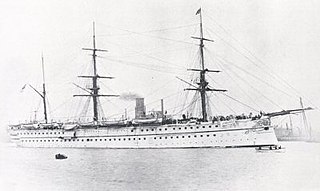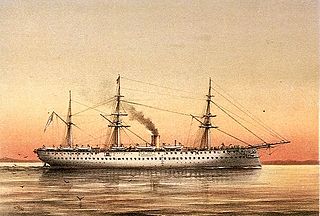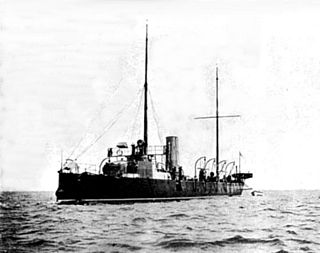
HMS Invincible was a Royal Navy Audacious-class ironclad battleship. She was built at the Napier shipyard and completed in 1870. Completed just 10 years after HMS Warrior, she still carried sails as well as a steam engine.

HMS Dreadnought was an ironclad turret ship built for the Royal Navy during the 1870s. Construction was halted less than a year after it began and she was redesigned to improve her stability and buoyancy. Upon completion in 1879, the ship was placed in reserve until she was commissioned in 1884 for service with the Mediterranean Fleet. Upon her return 10 years later, she became a coast guard ship in Ireland for two years. The ship then became a depot ship in 1897 before she was reclassified as a second-class battleship in 1900. Dreadnought participated in the annual fleet manoeuvres for the next two years before she became a training ship in 1902. The ship was taken out of service three years later and sold for scrap in 1908.

HMS Hawke, launched in 1891, was the seventh British warship to be named Hawke. She was an Edgar-class protected cruiser. In September 1911 the Hawke collided with the ocean liner RMS Olympic. The damage smashed the Hawke's bow and damaged the stern of the Olympic.

HMS Serapis was a Euphrates-class troopship commissioned for the transport of troops to and from India. She was launched in the Thames on 26 September 1866 from the Thames Ironworks and Shipbuilding Company at Leamouth, London and was the third Royal Navy ship to bear the name. She was sold in 1894.
HMS Zebra was a "Twenty-seven Knotter" destroyer of the Royal Navy, later classified as part of the A Class. Zebra was built by Thames Iron Works and launched in 1895 as the fifth Royal Navy ship to be named Zebra. Entering service in 1900, Zebra was sold for scrap in 1914.
HMS Trident was an iron paddle sloop built for the Royal Navy by Ditchburn & Mare in 1845 at Leamouth, London. She served in the Mediterranean, off West Africa and in the South Atlantic, and was broken up in 1866.

HMS Violet was a Doxford three-funnel, 30-knot destroyer ordered by the Royal Navy under the 1896–1897 Naval Estimates. She was the seventh ship to carry this name since it was introduced in 1588 for a 200-ton vessel.
HMS Osprey was a three-funnel, 30-knot destroyer ordered by the Royal Navy under the 1896–1897 Naval Estimates from Fairfields. She was the fifth ship to carry this name since it was introduced in 1797 for an 18-gun ship-sloop.

HMS Himalaya was built for the Peninsular and Oriental Steam Navigation Company as SS Himalaya, a 3,438 gross register ton iron steam screw passenger ship. She was purchased by the Royal Navy in 1854 for use as a troopship until 1894 and was then moored in the Hamoaze, Devonport to serve as a Navy coal hulk until 1920, when sold off. She was sunk during a German air attack on Portland Harbour in 1940.

HMS Euphrates was an iron-hulled troopship of the Euphrates class. She was designed for the transport of British troops to India, and launched in the River Mersey on 24 November 1866 by Laird Brothers of Birkenhead. She was the fourth and last Royal Navy ship to bear the name.

HMS Crocodile was a Euphrates-class troopship launched into the Thames from the Blackwall Yard of Money Wigram and Sons on 7 January 1867. She was the fourth and last vessel of the Royal Navy to carry the name.

HMS Malabar was a Euphrates-class troopship launched in 1866, and the fifth ship of the Royal Navy to employ the name. She was designed to carry troops between the United Kingdom and British India, and was employed in that role for most of her life. She became the base ship at the Royal Naval Dockyard, Bermuda in 1897, was renamed HMS Terror in 1901 and was sold in 1918. Her name was later used as the stone frigate to which shore personnel in Bermuda were enrolled, and later for Her Majesty's Naval Base Bermuda, after the 1950s, when the dockyard was reduced to a base.

HMS Reindeer was a Royal Navy Mariner-class composite screw gunvessel of 8 guns.

HMS Racer was a Royal Navy Mariner-class composite screw gunvessel of 8 guns.

The Euphrates class was a five-ship class of iron screw troopships built for the Royal Navy during the 1860s. They were used for carrying troops to India, with two of them being later hulked and surviving into the early 20th Century.

HMS Rattlesnake was a unique design of torpedo gunboat of the Royal Navy. A result of the Russian war scare of 1885, she was designed by Nathaniel Barnaby that year and built by Laird Brothers, of Birkenhead. Quickly made obsolete by the new torpedo boat destroyers, she became an experimental submarine target ship in 1906, and was sold in 1910.

HMS Icarus was a Mariner-class composite screw gunvessel of 8 guns, and the third Royal Navy vessel to carry the name. She was launched in 1885 at Devonport and sold in 1904.

HMS Constance was a Comus-class steel corvette of the Royal Navy. She was launched from Chatham Dockyard on 9 June 1880.

HMS Mallard was a two funnel, 30-knot destroyer ordered by the Royal Navy under the 1894 – 1895 Naval Estimates. She served in Home waters both before and during the First World War, and was sold for breaking in 1920.

HMS Angler was a two-funnel, 30-knot destroyer ordered by the Royal Navy under the 1895 – 1896 Naval Estimates. She was the second ship to carry this name. She was launched in 1897, served at Chatham and Portsmouth and was sold for breaking in 1920.


















